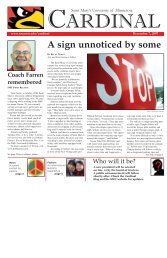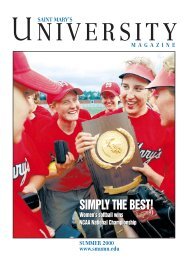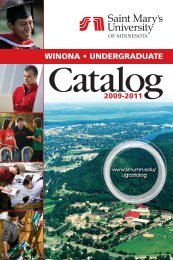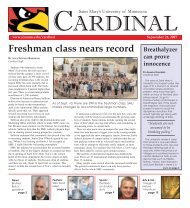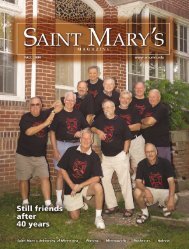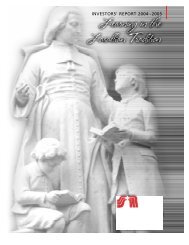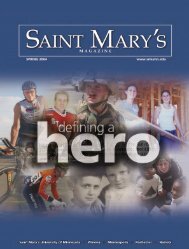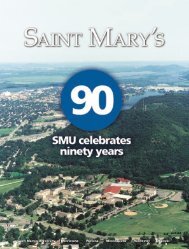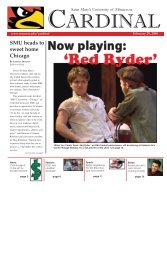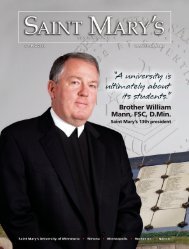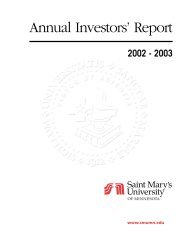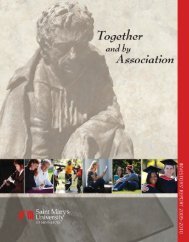& Student Handbook - Saint Mary's University of Minnesota
& Student Handbook - Saint Mary's University of Minnesota
& Student Handbook - Saint Mary's University of Minnesota
You also want an ePaper? Increase the reach of your titles
YUMPU automatically turns print PDFs into web optimized ePapers that Google loves.
58 Undergraduate Certificate Programs<br />
ST110<br />
Anatomy and Physiology (5 cr./75 hrs.)<br />
Following a systems approach, this course covers the organization and<br />
structure <strong>of</strong> the human body with emphasis on the physiologic function<br />
and interdependence <strong>of</strong> organ systems. Topics include the organization <strong>of</strong><br />
the human body, cellular function, tissue classification, the integumentary,<br />
skeletal, muscular, nervous, respiratory, digestive, urinary, lymphatic,<br />
reproductive, endocrine, immune, and circulatory system (both central<br />
and peripheral), the special senses, and blood and body fluids.<br />
ST115<br />
Introduction to Surgical Technology (3 cr./45 hrs.)<br />
This course provides the student with a broad background <strong>of</strong> today’s<br />
American healthcare industry and the role <strong>of</strong> health care providers with<br />
an emphasis on surgical technology. Specific topics include the history <strong>of</strong><br />
the development <strong>of</strong> surgery as a medical specialty, health care delivery<br />
systems and facilities, hospital organization and management,<br />
introduction to the surgical team, the role and function <strong>of</strong> surgical<br />
technologists, and the ethical, moral, and legal responsibilities applicable<br />
to implementing standards <strong>of</strong> care. The course includes in-depth<br />
discussion <strong>of</strong> a patient’s emotional and physical response to illness and<br />
surgery. In addition the student is introduced to the physical layout <strong>of</strong> an<br />
operating room, including furniture, proper attire, and traffic patterns and<br />
to the chemical, biological, and physical hazards.<br />
ST120<br />
Health Care Ethics (1 cr./15 hrs.)<br />
This course presents the ethical theories and conceptual framework that<br />
support ethical decision-making. The Surgical Technologist Code <strong>of</strong><br />
Ethics, ethical events that occur within the operative setting, and<br />
pr<strong>of</strong>essional responsibility in the delivery <strong>of</strong> safe, effective and competent<br />
patient care by the Surgical Technologist are presented.<br />
SEMESTER TWO<br />
ST150<br />
Microbiology and Wound Healing (3 cr./45 hrs.)<br />
This course addresses the structure and function <strong>of</strong> the cell, pathogenic and<br />
non-pathogenic organisms, microscopy and the microscope, classification<br />
<strong>of</strong> microorganisms, genetics, growth factors, and other characteristics <strong>of</strong><br />
bacteria, microbes and the environment, nosocomial infections, prevention<br />
<strong>of</strong> disease transmission, the three lines <strong>of</strong> body defense mechanisms,<br />
sanitation, sterilization, and disinfection, wound healing, the infectious<br />
process and immune response. Allergy and hypersensitivity are addressed<br />
in terms <strong>of</strong> both patient and the surgical technologist. Special attention is<br />
paid to how tissues react and are restored to normal functions following<br />
surgical trauma.<br />
ST160<br />
Pharmacology (4 cr./60 hrs.)<br />
<strong>Student</strong>s review basic math skills and learn a framework <strong>of</strong> pharmacological<br />
principles in order to apply them in the surgical environment. Commonly<br />
used medication with surgical applications are reviewed in depth including<br />
antibiotics, diagnostic agents, diuretics, drugs affecting the gastrointestinal<br />
system, hormones, drugs that affect coagulation, ophthalmic agents,<br />
preoperative medications anesthesia agents for general and regional<br />
techniques. Specific topics include basic math with emphasis on the metric<br />
system, percentages, and proportions; basic pharmacological principles<br />
including pharmacokinetics and pharmacodynamics; drug administration<br />
routes and methods; blood and fluid usage; drug reactions including<br />
malignant hyperthermia; and, allergic reactions.<br />
ST170<br />
Operating Room Principles I (3 cr./45 hrs.)<br />
Prerequisite: An earned C (2.0) or better in ST115<br />
This course introduces the core principles <strong>of</strong> aseptic technique,<br />
sterilization and disinfection, the reprocessing <strong>of</strong> surgical instruments<br />
and supplies. Each student learns to perform a surgical scrub, don<br />
gowns and gloves, how to change gowns and gloves when<br />
contamination occurs, and how to gown and glove others. Patient<br />
transportation and patient positioning are demonstrated and practiced.<br />
Preparation <strong>of</strong> the patient for surgical procedures is covered including<br />
urinary catheterization and skin preparation. The course also includes<br />
the principles <strong>of</strong> draping a patient and setting up a back table and Mayo<br />
stand. Basic instrumentation, sutures and surgical needles are covered.<br />
Related topics addressed are the methods <strong>of</strong> achieving hemostasis, care<br />
and handling <strong>of</strong> specimens, the appropriate response to emergencies<br />
resulting from blood volume emergencies, respiratory emergencies,<br />
cardiac emergencies, malignant hyperthermia, anaphylactic allergic<br />
reactions and seizures.<br />
ST171<br />
Operating Room Application I (4 cr./60 hrs.)<br />
Prerequisite: An earned C (2.0) or better in ST115<br />
This course is designed to augment the classroom theory presented in<br />
ST170 and provides the opportunity to repeatedly scrub, gown and glove<br />
themselves and others, reprocess surgical supplies, activate the flash<br />
sterilization cycle, drape and set up a back table and Mayo stand with<br />
instruments and basic supplies appropriate for a laparotomy procedure,<br />
accept and label medications, drape a patient and take down the drapes<br />
and instruments following the conclusion <strong>of</strong> a procedure. Passing <strong>of</strong> the<br />
Skills Assessment <strong>of</strong> basic competence <strong>of</strong> aseptic technique, the setting<br />
up <strong>of</strong> a Mayo stand and back table, and draping <strong>of</strong> the patient is required.<br />
SEMESTER THREE<br />
ST250<br />
Operating Room Principles II (6 cr./90 hrs.)<br />
Concurrent registration is required in ST251<br />
This course reviews the pertinent anatomy, physiology, and common<br />
pathophysiology related to: general procedures, obstetrics and<br />
gynecological procedures, orthopedics, ENT, ophthalmology,<br />
neurological procedures, cardiothoracic and peripheral vascular surgery,<br />
urologic, maxill<strong>of</strong>acial, plastic, and pediatric procedures. Conditions that<br />
warrant surgical correction are discussed in depth. Common specialized<br />
instruments by type, function, name, and supplies are discussed in the<br />
context <strong>of</strong> each specialty. Common procedures in each <strong>of</strong> the surgical<br />
specialty areas are explained in detail including indication for surgery,<br />
anatomy involved, anticipated incision, patient position and prepping,<br />
draping, and step-by-step explanation <strong>of</strong> the procedure. This course is<br />
coordinated with the content <strong>of</strong> ST251.<br />
ST251<br />
Operating Room Application II (6 cr./90 hrs.)<br />
Concurrent registration is required in ST250<br />
Prerequisite: A grade <strong>of</strong> C (2.0) or better in ST170, and passage <strong>of</strong> the<br />
Skills Assessment in ST171<br />
This course provides the clinical environment in which to practice the<br />
theories and skills covered in ST250. <strong>Student</strong>s have repeated<br />
opportunities to scrub, gown and glove themselves and others, drape<br />
and set up a Mayo stand and back table appropriate for general<br />
laparotomy, gynecological, orthopedic, ENT, and urologic procedure.<br />
Each student learns to handle instruments, suture and needles and



